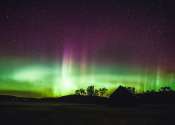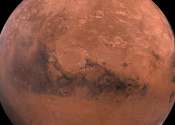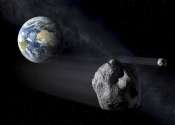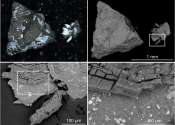Last update:
Planetary Sciences news

New study shows mysterious solar particle blasts can devastate the ozone layer, bathing Earth in radiation for years
The remarkable aurora in early May this year demonstrated the power that solar storms can emit as radiation, but occasionally the sun does something far more destructive. Known as "solar particle events," these blasts of ...
Planetary Sciences
1 hour ago
0
0

New satellite aims to show how AI advances Earth observation
Artificial intelligence technologies have achieved remarkable successes and continue to show their value as backbones in scientific research and real-world applications.
Planetary Sciences
1 hour ago
0
0

Determining the safest Mars caves for future astronauts
When astronauts land on Mars someday, they might have to live in lava caves or lava tubes to survive the harsh radiation that rains down on the Martian surface every second. But which caves could offer them the best chance ...
Space Exploration
22 hours ago
0
1

With X-ray analysis, an asteroid provides a view into our solar system's past
Imagine opening a time capsule, hoping to learn about the ancient past. Except, instead of a box or a chest, it's an asteroid that could provide insights into the very dawn of life on Earth.
Planetary Sciences
22 hours ago
0
26

Moon 'swirls' could be magnetized by unseen magmas
Lunar swirls are light-colored, sinuous features on the moon's surface, bright enough to be visible from a backyard telescope. Some people think they look like the brushstrokes in an abstract painting. But these are not mere ...
Planetary Sciences
Jul 1, 2024
0
33

Studying the mystery of Uranus's curiously weak radiation belts
When the Voyager 2 spacecraft visited Uranus almost 50 years ago, it discovered a magnetic mystery. Unlike on most planets, the ice giant's magnetic field is tilted roughly 60° away from its spin axis, creating an asymmetric ...
Planetary Sciences
Jul 1, 2024
0
74

Analysis of NASA InSight data suggests Mars hit by meteoroids more often than thought
NASA's Mars InSight Lander may be resting on the Red Planet in retirement, but data from the robotic explorer is still leading to seismic discoveries on Earth.
Planetary Sciences
Jun 28, 2024
2
67

A harmless asteroid will whiz past Earth Saturday. Here's how to spot it
An asteroid will whiz harmlessly past Earth this weekend. With the right equipment and timing, you just might spot it.
Space Exploration
Jun 28, 2024
0
264

Earth from space: Meteor Crater
Ahead of Asteroid Day (June 30), the Copernicus Sentinel-2 mission takes us over the Meteor Crater, also known as the Barringer Meteorite Crater.
Planetary Sciences
Jun 28, 2024
0
63

Scientists clarify origins of lunar metallic iron
In a study published in Nature Astronomy, Profs. Shen Laiquan, Bai Haiyang, et al. from Prof. Wang Weihua's group at the Institute of Physics of the Chinese Academy of Sciences have clarified the respective effects of irradiation ...
Planetary Sciences
Jun 28, 2024
0
14

Mapping the red planet with the power of open science
Combining images from orbit with images from the surface, a JPL-developed tool allows researchers to zoom in to see individual boulders and zoom out to see all of Mars.
Planetary Sciences
Jun 28, 2024
0
26

Asteroid rocks begin to reveal our solar system's origins
Curtin University researchers are among a global team of scientists who are discovering how our solar system came to be, by uncovering the secrets hidden within a 4.5-billion-year-old asteroid.
Planetary Sciences
Jun 28, 2024
0
43

New class of Mars quakes reveals daily meteorite strikes
An international team of researchers, co-led by ETH Zurich and Imperial College London, has derived the first estimate of global meteorite impacts on Mars using seismic data. Their findings indicate that between 280 to 360 ...
Planetary Sciences
Jun 28, 2024
0
259

NASA's Mars Odyssey orbiter captures huge volcano, nears 100,000 orbits
NASA's longest-lived Mars robot is about to mark a new milestone on June 30: 100,000 trips around the Red Planet since launching 23 years ago. During that time, the 2001 Mars Odyssey orbiter has been mapping minerals and ...
Planetary Sciences
Jun 27, 2024
0
248

Image: Proba-2's glimpse of home
As ESA's veteran Proba-2 mission monitors the sun, it also takes occasional glimpses back to its homeworld—as seen in this expansive view of western Europe.
Planetary Sciences
Jun 27, 2024
0
15

The density difference of sub-Neptunes finally deciphered
An international team led by UNIGE, UNIBE and PlanetS has shown the existence of two distinct populations of sub-Neptunes, resolving a debate in the scientific community.
Astronomy
Jun 27, 2024
0
81

Detective work enables Perseverance Mars rover team to revive SHERLOC instrument
After six months of effort, an instrument that helps the Mars rover look for potential signs of ancient microbial life has come back online.
Planetary Sciences
Jun 26, 2024
0
571

NASA's Juno probe gets a close-up look at lava lakes on Jupiter's moon Io
New findings from NASA's Juno probe provide a fuller picture of how widespread the lava lakes are on Jupiter's moon Io and include first-time insights into the volcanic processes at work there. These results come courtesy ...
Planetary Sciences
Jun 26, 2024
2
472

Looking for atmospheres in the ultimate quest for extraterrestrial life
To look for atmospheres around planets outside our solar system is to look for extraterrestrial life. Astronomist Sebastian Zieba has used data from the James Webb Space Telescope to study small rocky exoplanets but found ...
Planetary Sciences
Jun 26, 2024
0
1

Surprising phosphate finding in NASA's OSIRIS-REx asteroid sample
Scientists have eagerly awaited the opportunity to dig into the 4.3-ounce (121.6-gram) pristine asteroid Bennu sample collected by NASA's OSIRIS-REx (Origins, Spectral Interpretation, Resource Identification, and Security—Regolith ...
Planetary Sciences
Jun 26, 2024
0
113
More news

New warm sub-Neptune exoplanet discovered with TESS

New study reveals comet airburst evidence from 12,800 years ago

NASA, SpaceX launch NOAA's latest weather satellite

Time to build zero-debris satellites

US launches satellite to better prepare for space weather

Astronomers find three potential super-Earths around nearby star

Two large asteroids safely pass Earth just 42 hours apart

Venus could be the perfect place to count meteors

Why scientists are intrigued by air in NASA's Mars sample tubes
Other news

New AI program helps identify elusive space plasmoids

Scientists crack new method for high-capacity, secure quantum communication

Study reveals fireworks' impact on air quality

Research shows how RNA 'junk' controls our genes

Researchers develop low-cost light sheet fluorescence microscope

Biomolecular condensate 'molecular putty' properties found encoded in protein sequence

Shining a light on mental health in the planetary science community

It's summer solstice time. What does that mean?

NASA selects Lockheed Martin to build next-gen spacecraft for NOAA

Scientists discover massive energy imbalance on Saturn

In the hunt for a second Earth, look to small planets, says new research

Perseverance finds 'popcorn'-like rocks on planet Mars

Tropical solstice shadows

New methodology advances self-assembly of dual-functional supramolecular materials

Ants perform amputations to save injured nestmates

Searching for the missing link between growth and longevity


































